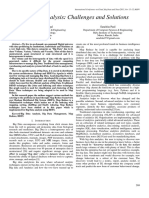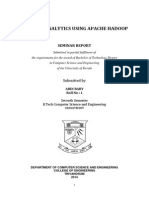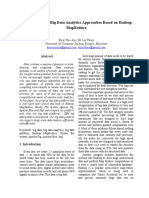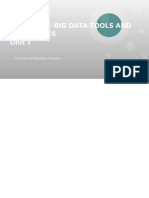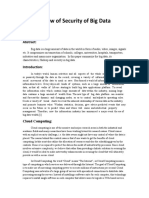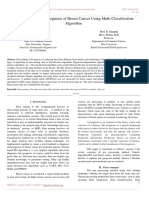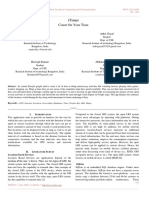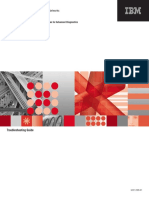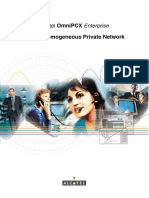Document Clustering With Map Reduce Using Hadoop Framework
Document Clustering With Map Reduce Using Hadoop Framework
Uploaded by
Editor IJRITCCCopyright:
Available Formats
Document Clustering With Map Reduce Using Hadoop Framework
Document Clustering With Map Reduce Using Hadoop Framework
Uploaded by
Editor IJRITCCCopyright
Available Formats
Share this document
Did you find this document useful?
Is this content inappropriate?
Copyright:
Available Formats
Document Clustering With Map Reduce Using Hadoop Framework
Document Clustering With Map Reduce Using Hadoop Framework
Uploaded by
Editor IJRITCCCopyright:
Available Formats
International Journal on Recent and Innovation Trends in Computing and Communication
Volume: 3 Issue: 1
ISSN: 2321-8169
409 - 413
_______________________________________________________________________________________________
Document Clustering with Map Reduce using Hadoop Framework
Satish Muppidi*
M. Ramakrishna Murty
Department of IT,
GMRIT, Rajam, AP, India
msatishmtech@gmail.com
Department of CSE
GMRIT, Rajam, AP, India
ramakrishna.malla@gmail.com
AbstractBig data is a collection of data sets. It is so enormous and complex that it becomes difficult to processes and analyse using normal
database management tools or traditional data processing applications. Big data is having many challenges. The main problem of the big data is
store and retrieve of the data from the search engines. Document data is also growing rapidly in the eon of internet. Analysing document data is
very important for many applications. Document clustering is the one of the important technique to analyse the document data. It has many
applications like organizing large document collection, finding similar documents, recommendation system, duplicate content detection, search
optimization. This work is motivated by the reorganization of the need for a well efficient retrieve of the data from massive resources of data
repository through the search engines. In this work mainly focused on document clustering for collection of documents in efficient manner
using with MapReduce.
KeywordsDocument Clustering, Map-Reduce, Hadoop, Document pre-processing
__________________________________________________*****_________________________________________________
I. INTRODUCTION
Document clustering is the use of cluster analysis of
textual documents. It has many applications like organizing
large document collection, finding similar documents,
recommendation system, duplicate content detection, search
optimization. Document clustering has been considered for use
in a number of different areas of text mining and information
retrieval. There are many search engines that are using for
information retrieval, but the main challenge in front of the
search engine is to present relevant results of the user. Even
though there are many knowledge discovery tools to filter,
order, classify or cluster their search results exists, still user
make extra effects to find the required document. In order to
provide solution, combining the entire web mining based data
mining techniques. The web documents in each cluster can be
pre-processed clustered on Map Reduce.
Now a days huge data is producing by many social
networking websites, e-commerce websites, and many
organizations. Analysing this huge data is tedious task for any
organization. To analyse the huge data, database management
techniques may not be sufficient, so the big data came into
existence.
Big data is a collection of data sets that are enormous
and complex to manipulate or cross-examine with standard
algorithms or techniques. Now a days Big data is a very
popular term used to designate the exponential growth and
availability of both structured and unstructured data. Here the
question is what big data is and what small data is. For some
organizations small data can be a big data for some other
organizations.
Big data has challenges can be categorized into 3
challenges. They are 1. Volume: Big volume of data is gathered
and growing and growing daily , 2. Variety: Data is all sorts of
variety, and the data is not organized data, that is some data is
audios, videos, images, text messages, emails, documents,
books, log files, public and private records, transactions, so this
Big data contains both structured and unstructured data. Big
data is really challenging. Its challenging because of the
variety of data that it covers from structured data, such as
transactions we made daily or we calculate and store, to
unstructured data such as audio files, multimedia presentations
and video streams. 3. Velocity: Lot of data is coming at very
high speed. The main problem of the big data is store and
retrieve of the data from the search engines, recommendation
engines, fraud detection etc. Big data is creating the challenges,
and the Hadoop is addressing these.
A. Hadoop
Hadoop is set of tools that supports running of
applications on Big Data. Hadoop addresses the challenges in
the Big Data. Apache Hadoop is a software framework that is
used to easily write and run applications that process huge
amounts of data. Hadoop supports distributed applications, and
allows the distributed processing of bulk data sets through the
commodity servers. The Apache Hadoop project developed
software of open source type for reliable, scalable, efficient,
economical and distributed computing. Hadoop implements
map-reduce using Hadoop Distributed File System. Hadoop is
written with large clusters of computers in mind. The
applications runs on the Hadoop need a write-once-read-many
access model. The Apache Hadoop software library permits
for the disseminated processing of huge data sets through
clusters of nodes by simple programming models. Hadoop
software library is developed to scale up from single servers up
to many machines, each one offering local computation and
local storage. The library is designed to sense and handle
failures at the application layer, not like in the way of hardware
to deliver high availability. So that the data is disseminates a
highly- available service on top of the cluster computers. The
Hadoop framework has four modules, those are Hadoop
Common, Hadoop Distributed File System (HDFS), Hadoop
YARN, and Hadoop MapReduce.
Fig 1: Hadoop Consisting of 2 main parts
409
IJRITCC | January 2015, Available @ http://www.ijritcc.org
_______________________________________________________________________________________
International Journal on Recent and Innovation Trends in Computing and Communication
Volume: 3 Issue: 1
ISSN: 2321-8169
409 - 413
_______________________________________________________________________________________________
The underlying Hadoop Distributed File System
(HDFS) utilized by the Hadoop framework is targeted at
providing high throughput at the cost of increased latency.
Fig 2: HDFS Architecture
Hadoop is breaking the data into smaller pieces.
Thats why it is able to deal with the Big data. So after
breaking the data into smaller pieces the Hadoop is doing
computation in the following way. Hadoop breaks the
computation also into smaller pieces and then its sends each
slice of computation into each slice of data. The data is broken
down into equal pieces, then the computation will finish, then
their results are combined together, then this is what is sent
back to the application as a combined result. So this approach
is called the Map Reduce. This will do the computation into
pieces and combined the results and send back to the
application.
B. Map Reduce
Map/Reduce approach has been popular in order to
compute huge volumes of data Map/Reduce motivates to
redesign and convert the existing sequential algorithms to
Map/Reduce algorithms for big data. So that, this paper
presents the document clustering with Map/Reduce using
Hadoop framework. The algorithm is to sort data set and to
convert it to (key, value) pair to fit with Map/Reduce. The
operations of distributing, aggregating, and reducing data in
Map/Reduce should cause the bottle-necks. MapReduce is a
striking framework because it allows users to decompose the
data involved in computing documents similarity into
multiplication and summation stages separately in a way that it
is well matched to effective disk access across several nodes.
The Map-Reduce approach definitely shows the growth in the
space and running time in terms of number of documents.
Fig 3: Map Reduce Data Flow
Map/Reduce is an algorithm used in Artificial
Intelligence as functional programming. Solve the problems to
analyse huge volumes of data set in distributed computing
environment. Map/Reduce programming platform is
implemented in the Apache Hadoop project that develops opensource software for reliable, scalable, economical, efficient and
distributed computing. Users normally stores data rows in
labelled tables. A data row has a category of key and a number
of columns. The table stored lightly, so that rows in the same
table can have different columns. Hadoop can compose
hundreds of nodes that process and compute peta- or tera-bytes
of data working together. The map and reduce functions run on
distributed nodes in parallel. Each map operation can be
processed independently on each node and all the operations
can be performed in parallel.
Map/Reduce does not guarantee to increase the
performance even though we add more nodes because there is a
problem for distributing, aggregating, and reducing the large
data set among nodes against computing powers of additional
machines. The Map Reduce algorithm is for efficiently
computing pair wise document similarity in large document
collections. In addition to offering specific benefits for a
number of real-world tasks, that could be useful for a broad
range of text analysis problems.
II. DOCUMENT CLUSTERING
Before document clustering pre-processing is the one
of the viral method to get efficient results. In the following
described pre-processing method.
A. Stop word elimination
Stop words are words which are filtered out prior to,
or after, processing of natural language data. A stop word is a
commonly used word in our daily life, that a search engine has
been programmed to ignore, both when searching and when
retrieving them as a result of a search query. The major work is
to identify the mostly weighted words are called as keywords
for the documents that reduce the dimensions of the matrix.
Stop word elimination is done based on ASCII values of each
letter without considering the case (either lower case or upper
case) and sum the each letter corresponding ASCII value for
every word and generate the number. Assign number to
corresponding word, and keep them in sorted order.
410
IJRITCC | January 2015, Available @ http://www.ijritcc.org
_______________________________________________________________________________________
International Journal on Recent and Innovation Trends in Computing and Communication
Volume: 3 Issue: 1
ISSN: 2321-8169
409 - 413
_______________________________________________________________________________________________
B. Stemming
Stemming is the process for reducing modified words
to their stem, base or root forms generally a written word form.
Stem is a part of a word like ing, er, etc., The term is used with
slightly different meanings. An algorithm for removing
derivations endings and inflectional in order to reduce word
forms to a common stem. In this stemming algorithm the
suffixes and prefixes were eliminated according to the
conditions by which the stemming procedure was applied.
C. Clustering
Clustering is a group of similar objects. Cluster is a
collection of data objects, that are contains all similar objects,
and these objects are dissimilar to the other clusters objects. A
cluster of data objects can be treated collectively as one group
and so may be considered as a form of data compression.
Objects within the cluster have the high similarity in
comparison to one another but are dissimilar to objects in the
other clusters. Clustering principle: Maximizing the intra class
similarity and minimizing the inter class similarity.
III. MAP REDUCE
Map reduce is data parallel paradigm with message
passing. It is a pipelined procedure with two phases, that is map
phase and the reduce phase. Its a higher level abstraction,
programmers needs to specify what mapper needs to do and
reducer needs to do. Map-Reduce is the software framework
for writing the programs easily which processes huge amounts
of data in parallel on large clusters of commodity hardware in a
fault-tolerant, reliable manner. A Map-Reduce job usually
splits the input data into independent portions which are
processed by the map tasks in a parallel manner. The
framework sorts the outputs coming from the maps, and gives
to the reduce tasks as input. Naturally the input and the output
of the jobs are stored in the file system. The Map-Reduce
operates completely on <key, value> pairs, that is, the
framework sees the input to the job as a set of <key,
value> pairs and produces a set of <key, value> pairs as output
of the job. Map function is applied to the every input key-value
pair and it generates intermediate key-value pairs. These
intermediate <key, value> pairs are sorted and grouped by the
key. Reduce function is applied to sorted and grouped
intermediate key values. Reduce function emits the resultant
key-values.
A. Map/Reduce Algorithm:
Mapper:
1.
Reads each transaction of input file and generates the
data set of the items: (<V1>, <V2>, , <Vn>) where
< Vn>: (vn1, vn2,.. vnm)
2. Sort all data set <Vn> and generates sorted data set
<Un>: (<U1>, <U2>, , <Un>) where < Un>: (un1,
un2,.. unm)
3. Loop While <Un> has the next element; note: each list
Un is handled individually.
4. End Loop While
5. Data set is created as input of Reducer: (key, <value>)
= (ynl, <number of occurrences>)
Reducer:
1.
2.
Read (ynl, <number of occurrences>) data from
multiple nodes
Add the values for ynl to have (ynl, total number of
occurrences). The reducer is to accumulate the number
of values per key. Thus, its time complexity is O(v)
where v is the number of values per key.
Fig 4: Map Reduce Architecture
B. K-means Clustering:
K-Means clustering choose k initial points and mark
each as a center point for one of the k sets. Then for every item
in the total data set it marks which of the k sets it is closest to.
It then finds the average center of each set, by averaging the
points which are closest to the set. With the new set of centers
(centroid), it repeats the algorithm until convergence has been
reached.
The implementation of document clustering on
MapReduce accepts two input directories: one is the documents
directory with the output of calculating term frequencies, and
one is centers directory with k initial document centers. The k
initial document centers are chosen from the records of
documents directory. Note that the k-line document data have
the same terms as fewer as possible. In each of the iteration
MapReduce framework will partition the input files of
document directory into a set of M splits, and then these splits
are processed in parallel by M Map functions.
Map functions should determine which of the current
set of k document centers; the document is closest to and emits
411
IJRITCC | January 2015, Available @ http://www.ijritcc.org
_______________________________________________________________________________________
International Journal on Recent and Innovation Trends in Computing and Communication
Volume: 3 Issue: 1
ISSN: 2321-8169
409 - 413
_______________________________________________________________________________________________
a record containing the entire documents data and its chosen kcenter. The Reduce function receives a k-center and all
documents which are bound to this k-center. It should calculate
a new k-center, and put the new k-center in centers directory.
To evaluate the distance between any two documents, we use
the cosine similarity metric of term frequency, and use
arithmetic average to calculate the new k center. Note that the
contents in document directory will not change during the
process.
Document clustering for large collection can be
efficiently implemented with MapReduce. Initially we perform
the pre-processing on the dataset. In the document preprocessing stage, we design a new iterative algorithm to
calculate tfidf weight on MapReduce in order to evaluate how
important a term is to a document in a corpus. Then, a KMeans clustering is implemented on MapReduce to partition all
documents into k clusters in which each documents belongs to
the cluster with the same meaning. The map and reduce
functions run on distributed nodes in parallel. Each map
operation can be processed independently on each node and all
the operations can be performed in parallel. In map function,
the master node makes parts the input into sub problems, and
distributes those to worker nodes. Mapper reads the input data
and creates a list of items for each transaction. For each
transaction, its time complexity is O(n) where n is the number
of items for a transaction. In reduce function, the master node
takes the results to all the sub-problems and combines them to
get the output.
IV. RESULTS AND DISCUSSIONS
In our experiments we used Hadoop version 0.20.2 an
open source Java implementation of Map Reduce running on a
cluster. First the documents stop words will be removed. After
the stop word removal, then stemming process has been done.
So the each document the stop word removal and stemming
process has been done. Then by using the tfidf algorithm the
word count has taken from each document. Here we have taken
the large documents; the size of the document is more than 100
MB.
We have taken 7 large documents for clustering, the
following are the screenshots of the clustering documents, and
the 7 documents will be clustered into 3 groups.
Fig 5: Documents word count
In the following screen we can see that the input to the algorithm is 7 documents.
Fig 6: Input to the algorithm
Then the following screen showing that the 7
documents in the input folder will be clustered into cluster0,
cluster1 and cluster2. That means here 3 clusters created and
the 7 documents will be clustered into 3 clusters. The
documents centroid.txt, mydoc5.txt, mydoc1.txt, mydoc3.txt
documents entered into cluster0, the documents data.txt entered
into cluster1, mydoc2.txt, mydoc4.txt documents entered into
cluster2.
Fig 7: three clusters created
412
IJRITCC | January 2015, Available @ http://www.ijritcc.org
_______________________________________________________________________________________
International Journal on Recent and Innovation Trends in Computing and Communication
Volume: 3 Issue: 1
ISSN: 2321-8169
409 - 413
_______________________________________________________________________________________________
V. CONCLUSION AND FUTURE WORK
The main focus in this work is documents clustering
using Hadoop framework. In this work stopword elimination
and stemming methods are used to pre-process the input
documents and find keywords of every document and make
them into vector space model for document clustering. We used
iterative algorithm to calculate tfidf weight on MapReduce in
order to evaluate important a term is to a document in a corpus.
In the process of document clustering used K-means algorithm
procedure with distributed environment. We used a
MapReduce algorithm for efficiently computing pair wise
document similarity in large document collections. The map
and reduce functions run on distributed nodes in parallel. Each
map operation can be processed independently on each node
and all the operations can be performed in parallel.
Hadoop with Map/Reduce motivates the needs to
propose new algorithms for the existing applications that have
had algorithms for sequential computation. In the future work
we need to improve the scalability of the algorithm and also
cluster the document with different versions of the K-means
algorithm like incremental, bisecting and fuzzy c-means for
efficient results of document clustering.
[3]
[4]
[5]
[6]
[7]
[8]
[9]
[10]
[11]
[12]
REFERENCES
[1]
[2]
Rui Mximo Esteves, Thomas Hacker, Chunming Rong, A
new approach for accurate distributed cluster analysis for
Big Data: competitive K-Means Int. J. Big Data
Intelligence, Vol. 1, Nos. 1/2, 2014
M.RamakrishnaMurty, JVRMurty, Prasad Reddy PVGD, A
dimensionality reduced text data clustering with prediction
[13]
[14]
of optimal number of clusters International journal of
Applied Research on information technology and computing
Vol 2 Issue 2, 2011.
K. Grolinger, M. Hayes, W. Higashino, A. L'Heureux, D. S.
Allison, M. A. M. Capretz, Challenges for MapReduce in
Big Data, toappear in the Proc. of the IEEE 10th 2014
World Congress on Services (SERVICES 2014), June 27July 2, 1014, Alaska, USA.
Rachita Sony Krotha and Satish Muppidi, Performance
Evaluation of K-Means Algorithm and Enhanced
Mid-point based K-Means Algorithm on Mining Frequent
Patterns, International Journal of Advanced Research in
Computer Science and Software Engineering (IJARCSSE)
Vol 3 Issue 10, October 2013.
Tamer Elsayed and Jimmy Lin and Douglas W. Oard,
Pairwise Document Similarity in Large Collection with
Map Reduce, Proceedings of ACL-08, June 2008
Tom white, Hadoop the definitive guide.
WoohyuKim and Coord, MapReduce Debates and SchemaFree, March 2010.
Jian Wan and Wenming Yu and Xianghua Xu, Design and
Implement of Distributed Document Clustering Based on
Map Reduce, ISCSCT, December 2009
Jongwook Woo, Yuhang xu , Market Basket Analysis
Algorithm with Map/Reduce of Cloud Computing.
Apache Hadoop Project,, http://hadoop.apache.org/
Apache HBase, http://hbase.apache.org/
Michael Steinbach, George Karypis, and Vipin Kumar A
Comparison of Document Clustering Techniques
Jimmy Lin and Chris Dyer, Data-Intensive Text Processing
with MapReduce, Morgan & Claypool Publishers, 2010.
Jongwook Woo, Market Basket Analysis Example in
Hadoop,
http://dalcloudcomputing.blogspot.com/2011/03/marketbasket-analysis-example-in.html, March 2011
413
IJRITCC | January 2015, Available @ http://www.ijritcc.org
_______________________________________________________________________________________
You might also like
- An Insight On Big Data Analytics Using Pig ScriptDocument7 pagesAn Insight On Big Data Analytics Using Pig ScriptInternational Journal of Application or Innovation in Engineering & ManagementNo ratings yet
- Big Data 3Document16 pagesBig Data 3Royal HunterNo ratings yet
- Big Data AnalysisDocument8 pagesBig Data AnalysismjrobustNo ratings yet
- BDA Answers-1Document15 pagesBDA Answers-1afreed khanNo ratings yet
- MODULE 1 - STDocument13 pagesMODULE 1 - STjithugirish3424No ratings yet
- Hadoop PPTDocument25 pagesHadoop PPTsiv535No ratings yet
- Hadoop - Quick Guide Hadoop - Big Data OverviewDocument41 pagesHadoop - Quick Guide Hadoop - Big Data OverviewSelva KumarNo ratings yet
- Chapter - 2 HadoopDocument32 pagesChapter - 2 HadoopRahul PawarNo ratings yet
- Hadoop Notes Unit2Document24 pagesHadoop Notes Unit2manyamlakshmiprasannaNo ratings yet
- NOTES- BIG DATA ANALYTICS UNIT I, II, IIIDocument39 pagesNOTES- BIG DATA ANALYTICS UNIT I, II, IIIRupesh SushirNo ratings yet
- Hadoop Quick GuideDocument32 pagesHadoop Quick GuideRamanan SubramanianNo ratings yet
- Hadoop - Quick Guide Hadoop - Big Data OverviewDocument32 pagesHadoop - Quick Guide Hadoop - Big Data OverviewAkhilesh MathurNo ratings yet
- Big Data: Spot Business Trends, Prevent Diseases, C Ombat Crime and So On"Document8 pagesBig Data: Spot Business Trends, Prevent Diseases, C Ombat Crime and So On"Renuka PandeyNo ratings yet
- Big DataDocument4 pagesBig DataBal Kishan YadavNo ratings yet
- Business Intelligence Exam II AnswersDocument24 pagesBusiness Intelligence Exam II Answerstuchi0% (1)
- Unit 4 LTDocument16 pagesUnit 4 LTSahil KumarNo ratings yet
- Escritura 1Document7 pagesEscritura 1kennethNo ratings yet
- List Out The Best Practices of Big Dataanalytics.: Question Bank Part-ADocument89 pagesList Out The Best Practices of Big Dataanalytics.: Question Bank Part-ASUNIDHI GARGNo ratings yet
- Big Data Analytics Using Apache HadoopDocument33 pagesBig Data Analytics Using Apache HadoopAbinBabyElichirayilNo ratings yet
- Modeling of Big Data ProcessingDocument15 pagesModeling of Big Data ProcessingRocio LoayzaNo ratings yet
- Case StudyDocument16 pagesCase Study321506402298No ratings yet
- INSIDE CLOUD - CASE STUDYDocument11 pagesINSIDE CLOUD - CASE STUDYconstance9622No ratings yet
- Hadoop ReportDocument110 pagesHadoop ReportGahlot DivyanshNo ratings yet
- Exploration On Big Data Oriented Data Analyzing and Processing TechnologyDocument7 pagesExploration On Big Data Oriented Data Analyzing and Processing TechnologyRookie VishwakantNo ratings yet
- BI Unit1 NotesDocument4 pagesBI Unit1 NotesnilofarNo ratings yet
- The Growing Enormous of Big Data StorageDocument6 pagesThe Growing Enormous of Big Data StorageEddy ManurungNo ratings yet
- Integrating R and Hadoop For Big Data AnalysisDocument12 pagesIntegrating R and Hadoop For Big Data Analysisbogdan.oancea3651No ratings yet
- A Comparison of Big Data Analytics Approaches Based On Hadoop MapreduceDocument9 pagesA Comparison of Big Data Analytics Approaches Based On Hadoop MapreduceKyar Nyo AyeNo ratings yet
- Sentimental Analysis On Big Data Hadoop: AbstractDocument3 pagesSentimental Analysis On Big Data Hadoop: AbstractAbhishek MathurNo ratings yet
- A Survey On Compression Algorithms in HadoopDocument4 pagesA Survey On Compression Algorithms in HadoopEditor IJRITCCNo ratings yet
- MAPREDUCEFRAMEWORKDocument12 pagesMAPREDUCEFRAMEWORKgracesachinrockNo ratings yet
- ST-1 Solution Big Data KCS061Document26 pagesST-1 Solution Big Data KCS061Shivam GargNo ratings yet
- Testing Big Data: Camelia RadDocument31 pagesTesting Big Data: Camelia RadCamelia Valentina StanciuNo ratings yet
- Chapter 1Document4 pagesChapter 1Prakhar AgrawalNo ratings yet
- Hadoop Architecture and Its FunctionalityDocument7 pagesHadoop Architecture and Its FunctionalityJohnNo ratings yet
- Mapreduce: Simplified Data Analysis of Big Data: SciencedirectDocument9 pagesMapreduce: Simplified Data Analysis of Big Data: Sciencedirectmfs coreNo ratings yet
- Unit 1 Big DataDocument124 pagesUnit 1 Big Dataalexvictor987123No ratings yet
- A Survey On Estimation of Time On Hadoop Cluster For Data ComputationDocument4 pagesA Survey On Estimation of Time On Hadoop Cluster For Data ComputationNikhil TengliNo ratings yet
- Hadoop - MapReduceDocument51 pagesHadoop - MapReducedangtranNo ratings yet
- Radoop: Analyzing Big Data With Rapidminer and HadoopDocument12 pagesRadoop: Analyzing Big Data With Rapidminer and HadoopTijana DejanovićNo ratings yet
- Big Data Hadoop Training 8214944.ppsxDocument52 pagesBig Data Hadoop Training 8214944.ppsxhoukoumatNo ratings yet
- Big Data ArchitectureDocument17 pagesBig Data ArchitectureScribdTranslationsNo ratings yet
- Hadoop LabDocument32 pagesHadoop LabISS GVP100% (1)
- Big Data Analysis Concepts and ReferencesDocument60 pagesBig Data Analysis Concepts and ReferencesJamie Gibson100% (1)
- A Study On Big Data Processing Mechanism & Applicability: Byung-Tae Chun and Seong-Hoon LeeDocument10 pagesA Study On Big Data Processing Mechanism & Applicability: Byung-Tae Chun and Seong-Hoon LeeVladimir Calle MayserNo ratings yet
- What Is Big Data ?Document6 pagesWhat Is Big Data ?Meet MahidaNo ratings yet
- Big Data Emerging TechnologieDocument10 pagesBig Data Emerging TechnologieRahulNo ratings yet
- Map Reduce With Hadoop:: Presented by ANIVESHA-126 ARITRA-128 RIA-142 Shashvat - 150 SHEKHAR-151Document9 pagesMap Reduce With Hadoop:: Presented by ANIVESHA-126 ARITRA-128 RIA-142 Shashvat - 150 SHEKHAR-151Aritra Banerjee100% (1)
- Overview of Security IssuesDocument5 pagesOverview of Security IssuesMuhammadIrfanNo ratings yet
- Big DataDocument4 pagesBig DataPrakhar AgrawalNo ratings yet
- Unit 1Document28 pagesUnit 1Banuroopa VelkumarNo ratings yet
- Big Data: Concepts, Techniques, Storage and ChallengesDocument9 pagesBig Data: Concepts, Techniques, Storage and ChallengesRasmika SelvamNo ratings yet
- Big Data Analytics On Large Scale Shared Storage System: University of Computer Studies, Yangon, MyanmarDocument7 pagesBig Data Analytics On Large Scale Shared Storage System: University of Computer Studies, Yangon, MyanmarKyar Nyo AyeNo ratings yet
- Unit-I MaterialDocument32 pagesUnit-I Materialvishwathma2No ratings yet
- 3412ijwsc01 PDFDocument13 pages3412ijwsc01 PDFssambangi555No ratings yet
- Cs8091 Bigdata Analytics Question BankDocument40 pagesCs8091 Bigdata Analytics Question BankSupriya GhoshNo ratings yet
- Big Data Frameworks: Architectures, Tools, and Techniques for Managing Large-Scale Data. Comprehensive review of Apache Hadoop, Spark and Flink.From EverandBig Data Frameworks: Architectures, Tools, and Techniques for Managing Large-Scale Data. Comprehensive review of Apache Hadoop, Spark and Flink.No ratings yet
- Data as a Product: A Comprehensive Guide on How to Use the Full Value of DataFrom EverandData as a Product: A Comprehensive Guide on How to Use the Full Value of DataNo ratings yet
- Channel Estimation Techniques Over MIMO-OFDM SystemDocument4 pagesChannel Estimation Techniques Over MIMO-OFDM SystemEditor IJRITCCNo ratings yet
- Importance of Similarity Measures in Effective Web Information RetrievalDocument5 pagesImportance of Similarity Measures in Effective Web Information RetrievalEditor IJRITCCNo ratings yet
- A Review of 2D &3D Image Steganography TechniquesDocument5 pagesA Review of 2D &3D Image Steganography TechniquesEditor IJRITCCNo ratings yet
- A Review of Wearable Antenna For Body Area Network ApplicationDocument4 pagesA Review of Wearable Antenna For Body Area Network ApplicationEditor IJRITCCNo ratings yet
- IJRITCC Call For Papers (October 2016 Issue) Citation in Google Scholar Impact Factor 5.837 DOI (CrossRef USA) For Each Paper, IC Value 5.075Document3 pagesIJRITCC Call For Papers (October 2016 Issue) Citation in Google Scholar Impact Factor 5.837 DOI (CrossRef USA) For Each Paper, IC Value 5.075Editor IJRITCCNo ratings yet
- Channel Estimation Techniques Over MIMO-OFDM SystemDocument4 pagesChannel Estimation Techniques Over MIMO-OFDM SystemEditor IJRITCCNo ratings yet
- A Review of Wearable Antenna For Body Area Network ApplicationDocument4 pagesA Review of Wearable Antenna For Body Area Network ApplicationEditor IJRITCCNo ratings yet
- A Review of 2D &3D Image Steganography TechniquesDocument5 pagesA Review of 2D &3D Image Steganography TechniquesEditor IJRITCCNo ratings yet
- Diagnosis and Prognosis of Breast Cancer Using Multi Classification AlgorithmDocument5 pagesDiagnosis and Prognosis of Breast Cancer Using Multi Classification AlgorithmEditor IJRITCCNo ratings yet
- Prediction of Crop Yield Using LS-SVMDocument3 pagesPrediction of Crop Yield Using LS-SVMEditor IJRITCCNo ratings yet
- 45 1530697786 - 04-07-2018 PDFDocument5 pages45 1530697786 - 04-07-2018 PDFrahul sharmaNo ratings yet
- A Study of Focused Web Crawling TechniquesDocument4 pagesA Study of Focused Web Crawling TechniquesEditor IJRITCCNo ratings yet
- Itimer: Count On Your TimeDocument4 pagesItimer: Count On Your Timerahul sharmaNo ratings yet
- Predictive Analysis For Diabetes Using Tableau: Dhanamma Jagli Siddhanth KotianDocument3 pagesPredictive Analysis For Diabetes Using Tableau: Dhanamma Jagli Siddhanth Kotianrahul sharmaNo ratings yet
- Hybrid Algorithm For Enhanced Watermark Security With Robust DetectionDocument5 pagesHybrid Algorithm For Enhanced Watermark Security With Robust Detectionrahul sharmaNo ratings yet
- Safeguarding Data Privacy by Placing Multi-Level Access RestrictionsDocument3 pagesSafeguarding Data Privacy by Placing Multi-Level Access Restrictionsrahul sharmaNo ratings yet
- 41 1530347319 - 30-06-2018 PDFDocument9 pages41 1530347319 - 30-06-2018 PDFrahul sharmaNo ratings yet
- Paper On Design and Analysis of Wheel Set Assembly & Disassembly Hydraulic Press MachineDocument4 pagesPaper On Design and Analysis of Wheel Set Assembly & Disassembly Hydraulic Press MachineEditor IJRITCCNo ratings yet
- 49 1530872658 - 06-07-2018 PDFDocument6 pages49 1530872658 - 06-07-2018 PDFrahul sharmaNo ratings yet
- 44 1530697679 - 04-07-2018 PDFDocument3 pages44 1530697679 - 04-07-2018 PDFrahul sharmaNo ratings yet
- Outcomes Placement B1 - Alejandra - ColmenaresDocument11 pagesOutcomes Placement B1 - Alejandra - ColmenaresMARIA ALEJANDRA COLMENARES MUNOZNo ratings yet
- Makalah BIDocument6 pagesMakalah BIAchmad NaufalNo ratings yet
- 1ca370f3bd5c6f46 - 3Document2 pages1ca370f3bd5c6f46 - 3dudubebe1995No ratings yet
- Excel To PDF Using Visual BasicDocument2 pagesExcel To PDF Using Visual BasicJuniorNo ratings yet
- Evidence Going To The RestaurantDocument3 pagesEvidence Going To The Restaurantstefany paola barrios cabreraNo ratings yet
- Lampiran II Jadwal Semester Ganjil Tp. 2023-2024 (Draf)Document10 pagesLampiran II Jadwal Semester Ganjil Tp. 2023-2024 (Draf)adindatika585No ratings yet
- CATIA V5 Mechanical Surface Designer AdvancedDocument4 pagesCATIA V5 Mechanical Surface Designer AdvancedAbhishek ChavanNo ratings yet
- Emily Dickinson - Reading ActivitiesDocument4 pagesEmily Dickinson - Reading ActivitiesmirelaNo ratings yet
- Karl G. Grosse-Erdmann, Alfred Peris Manguillot Linear Chaos Universitext 2011Document399 pagesKarl G. Grosse-Erdmann, Alfred Peris Manguillot Linear Chaos Universitext 2011Wily Sarmiento YucraNo ratings yet
- A Tale of Two Cities As A Historical Novel EnglishDocument3 pagesA Tale of Two Cities As A Historical Novel Englishsameer muneerNo ratings yet
- Speech Theater and ArtsDocument8 pagesSpeech Theater and ArtsMILCAH PARAYNONo ratings yet
- Paradise LostDocument23 pagesParadise LostadnanNo ratings yet
- Tivoli: OMEGAMON XE For Mainframe NetworksDocument220 pagesTivoli: OMEGAMON XE For Mainframe NetworksJOE SCHOLTZNo ratings yet
- Gimel 2Document9 pagesGimel 2Frater MagusNo ratings yet
- AdfDocument15 pagesAdfRyan Ivan Capili Cruz50% (2)
- B.A. (H) English-2nd Semester-2018Document11 pagesB.A. (H) English-2nd Semester-2018sameyakhanam08No ratings yet
- 27964Document81 pages27964madehacetriNo ratings yet
- Ghadeer in QuranDocument7 pagesGhadeer in QuranSayeda ZahraNo ratings yet
- Student Worksheet Noun Phrase and AdverbDocument3 pagesStudent Worksheet Noun Phrase and AdverbRudi HaryantoNo ratings yet
- GoogleTest FAQ - GoogleTestDocument12 pagesGoogleTest FAQ - GoogleTestjordan1412No ratings yet
- DatasheetDocument29 pagesDatasheetYoussef BenadderNo ratings yet
- Document Shopping MallDocument14 pagesDocument Shopping Mallnitika60% (5)
- BBC Learning English: Working AbroadDocument6 pagesBBC Learning English: Working AbroadSufia SultanaNo ratings yet
- FINAL ITWS Lab Manual PDFDocument48 pagesFINAL ITWS Lab Manual PDFkiran_y2No ratings yet
- Group Ii: Psalms 31-60Document5 pagesGroup Ii: Psalms 31-60Anthony RajNo ratings yet
- Edward William Lane's Lexicon V4 36 MBDocument481 pagesEdward William Lane's Lexicon V4 36 MBELibraryPKNo ratings yet
- How To InstallDocument1 pageHow To InstallLeeroy JenkinsNo ratings yet
- Abc-F Homogeneous Private Network: Alcatel Omnipcx EnterpriseDocument68 pagesAbc-F Homogeneous Private Network: Alcatel Omnipcx EnterpriseAriel BecerraNo ratings yet
- 6 - JAVA Programming Tutorial - BASICSDocument53 pages6 - JAVA Programming Tutorial - BASICSOtilia GosaNo ratings yet
- COMPARISON OF ADJECTIVES + MeaningsDocument2 pagesCOMPARISON OF ADJECTIVES + MeaningsCikgu DatNo ratings yet


